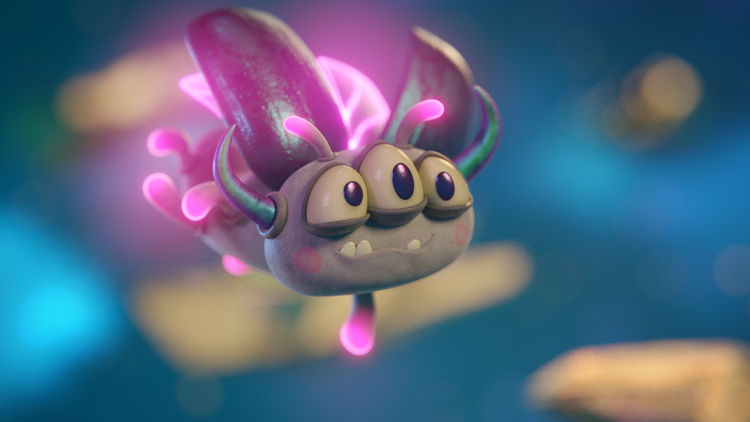Ape Squared, the bespoke NFT studio behind Space Bugs is set to launch an exciting new range of bugs and a game — Bankless Times writer, Khashayar Abbasi sits down with Space Bug Founder Sambi*, and Kelly-Anne Perera, the Vice President of Global Operations at Ape Squared to get the scoop.
Khashayar: What inspired you to get involved in the world of Crypto and NFTs?
Sambi: We stumbled into the crypto world around April of 2021. We were doing animation, art, and movies before, and we thought okay, NFTs sound like an interesting way of monetizing artwork in small chunks.
In the past, it would take a team of 200 people a few years to create a movie which would then sell for $10-$20. You may watch it multiple times but you only pay for it once. In that sense, the artistic value isn’t fully appreciated no matter how much you love the movie, which is not the case for other consumer goods— the more you like something, the more you spend on it.
NFTs are a way to really appreciate an artist’s work— because they equate demand with supply. We feel that more artists from the traditional movie/animation making world will start venturing into the NFT world because they can see results, and commercialize their work in a much faster way. They can break their work down into smaller pieces.
Kelly-Anne: Our studio has always been involved in animation and movie production, and it was partly down to COVID-19 that we changed focus onto more digital and NFT assets. We wanted to get on the train, so we started a new, NFT-focused studio, which we named Ape Squared, led by our head animators and character designers.
We’ve also now developed a gaming department so we have the two divisions working hand in hand. NFTs can be quite passive things, and that’s what we want to try and change so they’re not just pieces of art that sit in your wallet and once you’ve bought them they don’t do anything— we want to make them a lot more interactive.
Khashayar: So, SpaceBugs NFT, I quite like the name — how did you come up with the concept?
Sambi: Robbie was one of the founders of Ape Squared. He’s an award-winning animation director, having worked on countless projects in the past. When he signed up to do this, we started to brainstorm and came up with lore about how Space Bugs live in the Nebula and consume Blitzium as food, along with how in the Space Bug world, there would be different factions. We’re set to launch a new category of space bugs called, Rebel Bugs in our upcoming line — essentially creating a whole universe of different bug species.
At the time, no one was really doing 3D work. Every other project was pretty much 2D or had low artistic quality. We could have gone down that path and released something much sooner but we decided to let our art shine and create something really special that’s never been seen before.
Kelly-Anne: I think it’s worth mentioning that with the first wave of Space Bugs, they all had different characteristics, which dictated their rarity level, which then dictated their value. As Sambi mentioned, we have a new range coming out in a couple of months. They’re kind of similar but they have a new style to them. That’s not information that’s been released yet so that’s for all the community members who’ve been asking, so, there you go!
Khashayar: Awesome, so regarding Rebel Bugs— can we see the two worlds of Space Bugs and Rebel Bugs, in a way, coalescing?
Sambi: The lore or the story behind Space Bugs and Rebel Bugs are integrated. They’re two factions in the Nebula, and they’ve had disputes: Some members of the Space Bugs have decided to go rogue and become the Rebel Bugs.
The release will be a separate collection and owners of space bugs will get a Rebel Bug airdropped to their wallet. Consider Space Bugs as the genesis bugs in this universe. Holders of genesis bugs will always benefit from whatever we do in the future.
Khashayar: I’ve had a look at your website and I can see that you plan on developing a game, can you tell us more about this?
Kelly-Anne: Yes, we are making our NFTs more interactive. It’s called Stardust and it’s a form of our own community cryptocurrency— you can’t exchange it for dollars but you can exchange it for prizes. It’s not exclusive to our NFT holders; you don’t have to hold our NFT to take part in this. So from Friday [07/01/2022] onwards, you’ll be able to sign up for something called a Stardust wallet which is similar to Metamask, and from there, anybody who has held their Space Bug NFT for over a month (a diamond hand VIP holder), will have their Stardust backdated, meaning they’ll have a nice surprise when they sign up — a savings account already stored.
At Bankless Times we have access to some Stardust and we are offering $100 in Stardust for the first 10 people who share this article.
Similarly, the first 10 people to visit the @spacebugsnft Twitter and comment “Bankless” will get $100 in Stardust.
Anybody who isn’t a Space Bug holder can still sign up for the wallet and complete tasks. Daily tasks will be things like inviting people into our Discord channel for which you will get rewarded with Stardust. Depending on how many messages you send to the group, you could be rewarded with Stardust as well.
For Space Bug holders, we’re making it more interactive— so you now have to complete actions to make your Space Bug happy. You have to feed it, give it toys, etc, similar to Tamagotchi from back in the day. The happier your bug is, the more Stardust you will be rewarded with. If you’re not an NFT holder, but you’re still collecting Stardust, there’ll be a big raffle once a week and a free giveaway. For raffles, you use Stardust to enter. Prizes can be an Xbox, Netflix membership, among others.
Sambi: Stardust acts as a bridge for the eventual game that will come out. With the game, there will be a listed crypto token and all your Stardust will be moved over. We will always look after our NFT holders.
Khashayar: What are some challenges you faced during the development of this project?
Sambi: We had a lot of issues with bots, we almost lost our Discord server multiple times. There were scammers of course, and these are the biggest risks in crypto right now. I guess it comes with decentralization.
Kelly-Anne: Another issue we had was what we call paper hands—people who bought loads at minting then listed them at a really low price, which affects the floor price. To balance that out, we started rewarding anybody that held for over 30 days.
Khashayar: Your NFTs were minted on the Ethereum blockchain, but there are now alternative blockchains that offer faster and cheaper transactions, did you consider using other blockchains?
Sambi: For our bigger project down the line, that would have to happen on alternative blockchains, especially with all the transactions. Ethereum cannot support a proper game, so we will have to seek alternative blockchains. The good thing about Ethereum is that it has consensus and a lot of users but we are seeing interest in Solana and Near which are super fast and their technology is amazing. We’re in talks with other chains and we’re looking for their support.
Kelly-Anne: We did a lot of forecasting and predicting before we launched to find the best time for gas fees. I minted one myself during launch and the gas fees were around $30.
Khashayar: NFTs seem to be a rather polarizing subject— one side believes that NFTs are the future and the other believes that NFTs are destroying the Earth and nothing more than a scam — what’s your take?
Sambi: I’m a full believer that one day NFTs will completely overwhelm the in-game purchase market. One day, all in-game items will be NFTs. It’s a way that ensures users actually own the item they are buying. Without disclosing too much, we are looking to provide a solution where we welcome other NFT owners to bring their NFTs into our game, using layer 2 solutions to make the process frictionless. Through NFTs, we can incorporate a lot more than just Space Bugs into our world.
Kelly-Anne: As NFTs move into the mainstream, I think it will help to remove the stigma. I was at a conference a couple of weeks ago and Häagen-Dazs was doing a digital treasure hunt and by finding the NFT, you could trade it for a real, physical product. I think things like this can help people understand the potential of the technology.
Khashayar: What are the most exciting use cases of NFTs that you’ve come across? I know some music artists are allowing fans to own a share of their music and earn a percentage of their revenues. Is there potential here? And what sort of utility are you adding to your project?
Sambi: A lot of people are using NFTs as DAO tokens in a fund, it’s like crowdfunding and you get a share of the profits from investments. I think that’s very interesting. We want to create a world where you can bring NFTs that you bought elsewhere into our world. You will get rewarded with our token but we want to create a solid use-case for other NFTs within our world. For example, you could rent out your NFT to others to play with. We want to fully enable NFT staking and provide a real use case for NFTs in our world… but I don’t want to reveal too much right now.
Kelly-Anne: With Stardust integration, you get access to a membership scheme, where you can purchase bronze/silver/gold memberships depending on how much Stardust you have, giving you access to things. I won’t say too much but we’re working on giving members access to exclusive events with celebrities, influencers, and DJs. That said, we’re not being so closed door, you don’t have to be an NFT holder to partake — we want to create a space where anyone can come and access the event.
Khashayar: What advice would you give to someone who wants to create their own NFT project? What resources can they use to learn and get started?
Sambi: Number 1: don’t rug pull! It hurts the whole industry. Go and execute your roadmap in one form or another. Learn as you go, keep communicating with the community to hear their opinions. Number 2: prepare to not sleep much. Discord management is pretty much 24/7.
Kelly-Anne: Build your community before you launch anything. You get one chance to launch and if there’s no community to buy them then they just look like they’re dead and not worth buying. Spend a lot of time working on Discord, Twitter, Clubhouse, etc. Make sure you have a community and a fanbase that knows how the NFT system works. We held live AMAs for example. Just hosting educational information sessions to help explain what an NFT is can go a long way. We’re also looking to focus on working with influencers and celebrities to hold informational sessions in a fun and interactive way.
Sambi: A lot of people enter the NFT space thinking they’re going to become millionaires overnight. Many projects never take off, others are rug pulls. Only a small percentage become a blue-chip. It’s all about building solid fundamentals.
*Sambi is an alias.












